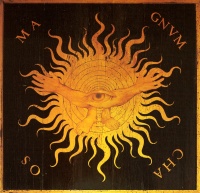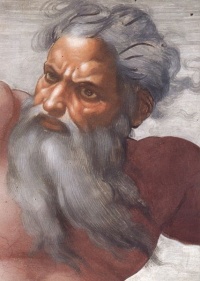Creation myth
From The Art and Popular Culture Encyclopedia
| Revision as of 14:03, 4 October 2008 Jahsonic (Talk | contribs) ← Previous diff |
Current revision Jahsonic (Talk | contribs) |
||
| Line 1: | Line 1: | ||
| + | [[Image:Magnum Chaos by Lorenzo Lotto and Giovan Francesco Capoferri.jpg|thumb|left|200px|''[[Magnum Chaos]]'' (c. 1524 ) by Lorenzo Lotto]] | ||
| + | {| class="toccolours" style="float: left; margin-left: 1em; margin-right: 2em; font-size: 85%; background:#c6dbf7; color:black; width:30em; max-width: 40%;" cellspacing="5" | ||
| + | | style="text-align: left;" | | ||
| + | "Before the [[ocean]] and the [[earth]] appeared— before the skies had overspread them all— the face of [[Nature]] in a vast expanse was naught but [[Chaos]] uniformly waste. It was a rude and undeveloped [[mass]], that nothing made except a ponderous weight; and all discordant elements confused, were there congested in a [[shapeless]] heap."--''[[Metamorphoses]]'' by Ovid | ||
| + | |} | ||
| + | [[Image:God.jpg|thumb|right|200px|Detail of [[Sistine Chapel]] fresco ''[[Creation of the Sun and Moon]]'' by [[Michelangelo]] (completed [[1512]]).]][[Image:Hands of God and Adam.jpg|thumb|200px|''[[Hands of God and Adam]]'' ([[1500s]]) is a detail of the [[Sistine Chapel ceiling ]] by [[Michelangelo]]. It is a detail from [[Adam and Eve on the Sistine Chapel ceiling|Adam and Eve cycle]]]] | ||
| {{Template}} | {{Template}} | ||
| - | A '''creation myth''' is a supernatural [[mythology|mytho-]][[religion|religious]] story or explanation that describes the beginnings of [[first man|humanity]], [[earth]], [[Abiogenesis|life]], and the [[universe]] ([[cosmogony]]), usually as a deliberate act of "creation" by one or more [[Deity|deities]]. | + | A '''creation myth''' is a [[symbol]]ic [[narrative]] of how the world began and how people first came to inhabit it. While in popular usage the term "[[Mythology|myth]]" often refers to false or fanciful stories, cultures regard their creation myths as true to varying degrees. In the society in which it is told, a creation myth is usually regarded as conveying profound [[truth (religious)|truths]], [[metaphor]]ically, symbolically and sometimes even in a [[history|historical]] or literal sense. They are commonly, although not always, considered [[cosmogonical]] myths—that is, they describe the ordering of the [[cosmos]] from a state of [[Chaos (cosmogony)|chaos]] or [[amorphous]]ness. |
| - | Many creation myths share broadly similar themes. Common [[Motif (literature)|motifs]] include the fractionation of the things of the world from a primordial chaos; the separation of the mother and father [[god]]s; land emerging from an infinite and timeless ocean; or creation ''[[ex nihilo]]''. | + | Creation myths often share a number of features. They often are considered [[sacred]] accounts and can be found in nearly all known [[religion|religious traditions]]. They are all stories with a [[plot (narrative)|plot]] and [[character (arts)|characters]] who are either [[deity|deities]], human-like figures, or animals, who often speak and transform easily. They are often set in a dim and nonspecific past, what historian of religion [[Mircea Eliade]] termed ''in illo tempore'' ("at that time"). Creation myths address questions deeply meaningful to the society that shares them, revealing their central [[worldview]] and the framework for the self-identity of the culture and individual in a universal context. |
| - | The term ''creation myth'' is sometimes used in a derogatory way to describe stories which are still believed today, as the term ''[[wikt:Myth|myth]]'' may suggest something which is absurd or fictional. While these beliefs and stories need not be a literal account of actual events, they may yet express ideas that are perceived by some people and cultures to be truths at a deeper or more symbolic level. Author [[Daniel Quinn]] notes that in this sense creation myths need not be religious in nature, and they have secular analogues in modern cultures. | + | Creation myths develop in [[oral tradition]]s and therefore typically have multiple versions and are the most common form of myth, found throughout human [[culture]]. |
| + | |||
| + | ==See also== | ||
| + | * [[Abiogenesis]] | ||
| + | * [[Allegorical interpretations of Genesis]] | ||
| + | * [[Creationism]] | ||
| + | * [[Big bang]] | ||
| + | * [[Book of Genesis]] | ||
| + | * [[Creation science]] | ||
| + | * [[Cosmogony]] | ||
| + | * [[Deluge (mythology)|Great flood]] | ||
| + | * [[Elohim]] | ||
| + | * [[Enuma Elish]] | ||
| + | * [[Evolutionary origin of religions]] | ||
| + | * [[Flying Spaghetti Monster]] | ||
| + | * [[Formation and evolution of the Solar System]] | ||
| + | * [[Intelligent Design]] | ||
| + | * [[Poimandres]] | ||
| + | * [[Origin myth]] | ||
| + | * [[World egg]] | ||
| + | ==See also== | ||
| + | * [[Cosmogony]] | ||
| + | * [[Evolutionary origin of religions]] | ||
| + | * [[List of creation myths]] | ||
| + | * [[Origin myth]] | ||
| + | * ''[[The Creation (Haydn)|The Creation]]'', oratorio written between 1796 and 1798 by [[Joseph Haydn]] | ||
| + | * [[World egg]] | ||
| - | Alternative creation myths abound in [[fantasy literature]]. J.R.R. Tolkien has his version in the Silmarillion; C.S. Lewis has both a Creation and an End in his Narnia sequence (Magician's Nephew and Last Battle). Also David Eddings 'Belgariad'; Robert Heinlein 'Job' and 'The Cat who walks through Walls'; Lois McMaster Bujold 'Chalion'; Charles Harness 'The New Reality'; Michael Moorcock and numerous others offer huge variety. Both Monotheist and Multitheist versions abound. The struggle between 'good' and 'evil' concept of Abrahamic religions is also a frequent element. | ||
| {{GFDL}} | {{GFDL}} | ||
Current revision

|
"Before the ocean and the earth appeared— before the skies had overspread them all— the face of Nature in a vast expanse was naught but Chaos uniformly waste. It was a rude and undeveloped mass, that nothing made except a ponderous weight; and all discordant elements confused, were there congested in a shapeless heap."--Metamorphoses by Ovid |

|
Related e |
|
Featured: |
A creation myth is a symbolic narrative of how the world began and how people first came to inhabit it. While in popular usage the term "myth" often refers to false or fanciful stories, cultures regard their creation myths as true to varying degrees. In the society in which it is told, a creation myth is usually regarded as conveying profound truths, metaphorically, symbolically and sometimes even in a historical or literal sense. They are commonly, although not always, considered cosmogonical myths—that is, they describe the ordering of the cosmos from a state of chaos or amorphousness.
Creation myths often share a number of features. They often are considered sacred accounts and can be found in nearly all known religious traditions. They are all stories with a plot and characters who are either deities, human-like figures, or animals, who often speak and transform easily. They are often set in a dim and nonspecific past, what historian of religion Mircea Eliade termed in illo tempore ("at that time"). Creation myths address questions deeply meaningful to the society that shares them, revealing their central worldview and the framework for the self-identity of the culture and individual in a universal context.
Creation myths develop in oral traditions and therefore typically have multiple versions and are the most common form of myth, found throughout human culture.
See also
- Abiogenesis
- Allegorical interpretations of Genesis
- Creationism
- Big bang
- Book of Genesis
- Creation science
- Cosmogony
- Great flood
- Elohim
- Enuma Elish
- Evolutionary origin of religions
- Flying Spaghetti Monster
- Formation and evolution of the Solar System
- Intelligent Design
- Poimandres
- Origin myth
- World egg
See also
- Cosmogony
- Evolutionary origin of religions
- List of creation myths
- Origin myth
- The Creation, oratorio written between 1796 and 1798 by Joseph Haydn
- World egg


